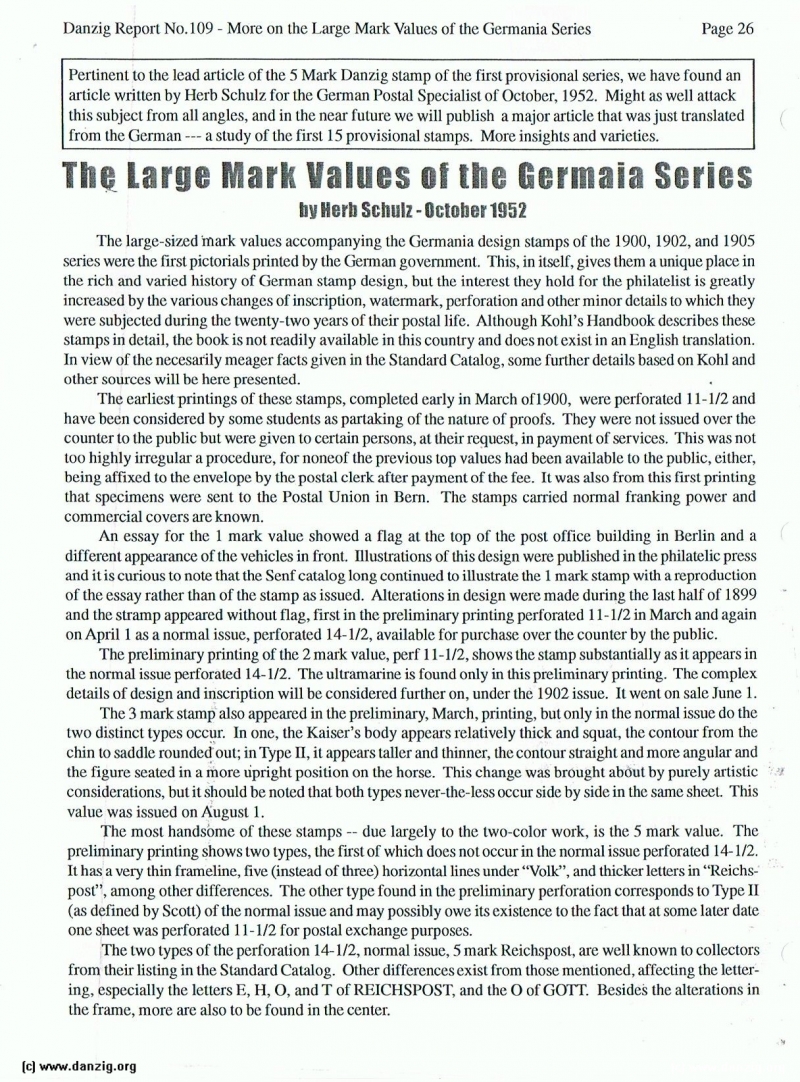
Pertinent to the lead article of the 5 Mark Danzig stamp of the first provisional series, we have found an article written by Herb Schulz for the German Postal Specialist of October, 1952. Might as well attack this subject from all angles, and in the near future we will publish a major article that was just translated ‘ from the German --- a study of the first 15 provisional stamps. More insights and varieties.
The Large Mark Values of the Germania Series
by Herb Schulz - October 1952
The large-sired mark values accompanying the Germania design stamps of the 1900, 1902, and 1905 series were the first pictorials printed by the German government. This, in itself, gives them a unique place in the rich and varied history of German stamp design, but the interest they hold for the philatelist is greatly increased by the various changes of inscription, watermark, perforation and other minor details to which they were subjected dUring the twenty-two years of their postal life. Although Kohl’s Flandhook describes these stamps in detail, the hook is not readily available in this country and does not exist in an English translation. In view of the necesarily meager facts given in the Standard Catalog, some further details based on Kohl and other sources will be here presented.
The earliest printings of these stamps, completed early in March of 1900, were perforated 11-1/2 and have been considered by some students as partaking of the nature of proofs. They were not issued over the counter to the public but were given to certain persons, at their request, in payment of services. This was not too highly irregular a procedure, for noneof the previous top values had been available to the public, either, being affixed to the envelope by the postal clerk after payment of the fee. It was also from this first printing that specimens were sent to the Postal Union in Bern. The stamps carried normal franking power and commercial covers are known.
An essay for the 1 mark value showed a flag at the top of the post office building in Berlin and a different appearance of the vehicles in front. Illustrations of this design were published in the philatelic press and it is curious to note that the Senf catalog long continued to illustrate the 1 mark stamp with a reproduction of the essay rather than of the stamp as issued. Alterations in design were made during the last half of 1899 and the stramp appeared without flag, first in the preliminary printing perforated 11-1/2 in March and again on April 1 as a normal issue, perforated 14-1/2, available for purchase over the counter by the public.
The preliminary printing of the 2 mark value, perf 11-1/2, shows the stamp substantially as it appears in the normal issue perforated 14-1/2. The ultramarine is found only in this preliminary printing. The complex details of design and inscription will be considered further on, under the 1902 issue. It went on sale June 1.
The 3 mark stamp also appeared in the preliminary, March, printing, hut only in the normal issue do the two distinct types occur. In one, the Kaiser’s body appears relatively thick and squat, the contour from the chin to saddle rounded out; in Type II, it appears taller and thinner, the contour straight and more angular and the figure seated in a more upright position on the horse. This change was brought about by purely artistic considerations, but it should be noted that both types never-the-less occur side by side in the same sheet. This value was issued on August 1.
The most handsome of these stamps -- due largely to the two-color work, is the 5 mark value. The preliminary printing shows two types, the first of which does not occur in the normal issue perforated 14-1/2. It has a very thin frameline, five (instead of three) horili)ntal lines under “Volk”, and thicker letters in “Reichsp ost”, among other differences. The other type found in the preliminary perforation corresponds to Type II (as defined by Scott) of the normal issue and may possibly owe its existence to the fact that at some later date one sheet was perforated 11-1/2 for postal exchange purposes.
The two types of the perforation 14-1/2, normal issue, 5 mark Reichspost, are well known to collectors from their listing in the Standard Catalog. Other differences exist from those mentioned, affecting the letteri ng, especially the letters B, H, 0, and T of REICHSPOST, and the 0 of GOT!’. Besides the alterations in the frame, more arc also to be found in the center.
Danzig Report Vol. 1 - Nr. 109 - October - November - December - 2000, Page 32.
Hits: 1557
Added: 29/07/2015
Copyright: 2024 Danzig.org

